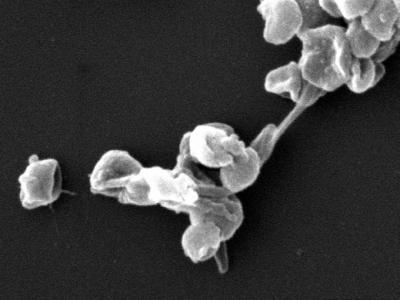Nitrososphaera viennensis
A Microbial Biorealm page on the genus Nitrososphaera viennensis
Classification
Higher order taxa
Domain: Archaea; Phylum: Thaumarchaeota; Order: Nitrososphaerales; Family: Nitrososphaeraceae
Species
Nitrososphaera viennensis

Description and significance
N. viennensis is a spherical ammonia oxidizing archaeon (AOA) isolated from garden soil in Vienna(2). It was the first cultivated terrestrial archaeal ammonia oxidizer(2) and may be used as a model organism in future studies(1). A single cell has a diameter of approximately 0.5-0.8 &mu m(2). Ammonia oxidizing archaea such as N. viennensis may contribute to the nitrification of the environment(2). It was previously believed only bacteria could oxidize ammonia(2). Ammonia oxidation is the first step in nitrification (NH3 to NO2-) (1). Eventually N2O is produced in this process and escapes into the environment (1). N2O has a greenhouse warming potential 310 times higher than CO2(1). It is responsible for 5%-7% of the greenhouse effect(1). It is the third most important greenhouse gas after CO2 and CH4(1). It is believed that ammonia oxidizing bacteria and archaea contribute toabout 70% of global N2O emissions(1).
Genome structure
Ammonia oxidizing bacteria aerobically oxidize ammonia using ammonia monooxygenase (AMO) to catalyze the initial oxidation of NH3. Ammonia oxidizing archaea have amo-like genes that may contribute to their ammonia oxidation(1).
Metabolism
N. viennensis grew on urea or ammonia as an energy source in laboratory conditions(2). Its optimal temperature is 35° C with an optimum pH of 7.5(2). Generation time of a pure culture with 1mM ammonia and pyruvate was about 45h(2). Cell densities reached 5 X 710 cells mL-1(2). It is able to withstand higher ammonia concentrations than the only other pure isolate from ammonia oxidizing archaea, Nitrosopumilus maritimus(2). Ammonia tolerances were similar to oligotrophic bacterial ammonia oxidizers(2). It is able to grow chemolithoautotrohically with inorganic compounds as an electron donor, but displayed higher growth rates when it is grow with bacteria or with the addition of pyruvate(2). It is currently unknown whether it is capable of heterotrophic or mixotrophic growth(2). The addition of vitamins, amino acids, and sugars had only a marginal effect on growth(2). Acetylene is a possible growth inhibitor(2). The electron transfer process is not fully understood yet in ammonia oxidizing archaea(1). The amount of ATP per mole of NH3 is unknown since it varies depending on growth stage and other factors(1). Lack of cytochrome c proteins and many copper-containing proteins suggest a different electron transport mechanism than ammonia oxidizing bacteria, which is iron-heme-dependent(1).
Ecology
N. viennensis exists in soil globally(1).
References
1. Hatzenpichler, Roland (2012) Diversity, Physiology, and Niche Differentiation of Ammonia- Oxidizing Archaea, Applied and Environmental Microbiology 2012 Nov: 78(21): 7501-10. doi: 10.1128/AEM.01960-12.
2. Tourna, Maria, M. Stieglmeier, A. Spang, M. Könneke, A. Schintlmeister, T. Urich, M. Engel, M. Schloter, M. Wagner, A. Richter, and C. Schleper (2011) Nitrososphaera viennensis, an ammonia oxidizing archaeon from soil, PNAS 2011 ; doi:10.1073/pnas.1013488108
3. University of Vienna (2011) Novel microorganism 'Nitrososphaera viennensis' isolated. ScienceDaily, 2011 April 28. Retrieved April 28, 2013, from http://www.sciencedaily.com/releases/2011/04/110425153556.htm
Edited by Shanna Lovelace of Dr. Lisa R. Moore, University of Southern Maine, Department of Biological Sciences, http://www.usm.maine.edu/bio
